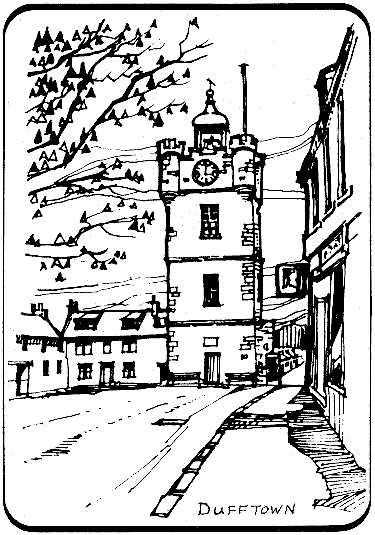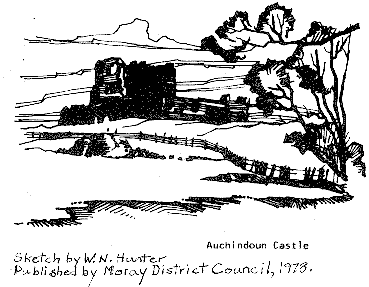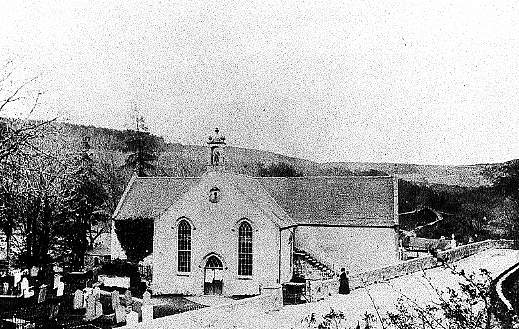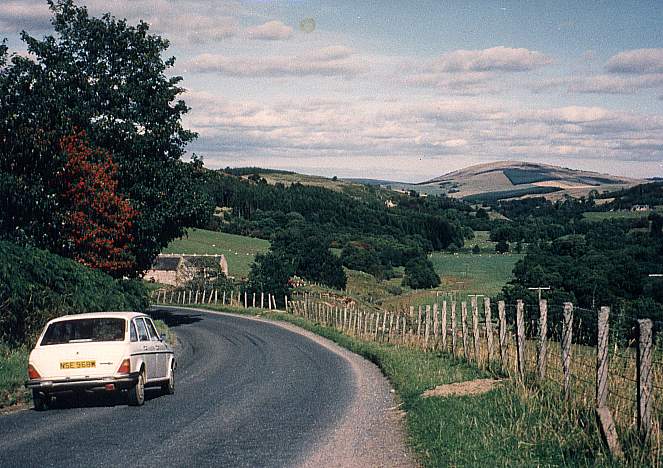
Up: Table of Contents
Previous: Background in Scotland
Next: Emigration to Canada

RED SANDY'S YOUTH IN SCOTLAND: 1810s - 1820sWhen the spring lambs were dotting the hill pastures, in May 1813, Alexander Stewart was born in Mortlach parish, Banffshire, Scotland. We know this only from family tradition and his obituaries, not from the records of the parish, for he was not baptized and recorded by the Church of Scotland, as far as we can discover. He was named Alexander, the name of a paternal uncle Alexander, born in 1768. The name Alexander was (including its Gaelic form, Alasdair) a popular name in Scotland and very common in the northeast, as was his nickname, Sandy, the usual diminutive for Alexander. The name had been introduced by King Malcolm Canmore and his wife, Queen (and Saint) Margaret. Three medieval kings of Scotland bore that name. Margaret had been brought up in the Hungarian court not far in miles (though far in time) from the Macedonia of Alexander the Great, the famous conqueror. The name was Greek, meaning "helper or defender of man". Alexander Stewart was well-named as, in adulthood, he became, indeed, a helper of man, a pastor to the needy pioneers and native people of Canada. Alexander's childhood home was Balveny (or Balvenie), a small community or fermtoun below the old ruins of Balvenie Castle in Glenfiddich.Across the fields was Maltkiln, where his father had formerly lived for many years and where his half-brothers and -sisters had been born. Farther up hill to the west was Hillside, the community where his grandparents had lived and where his father and uncles had been born. Within a short walk lived a number of Sandy's relatives on farms belonging to the Earl of Fife. They were probably descended from one or more of the many Stewarts who had migrated to the Banffshire hills and glens after John Stewart, half-brother of King James II, and Earl of Atholl, acquired the Balvenie lands in 1460 as part of his wife's dowry. Some Stewarts were descended from the many legitimate and natural sons of rapacious Alexander Stewart, Earl of Buchan, "the Wolf of Badenoch". Others were descendants of a William Stewart whose line was known for a while by the patronymic MacWilliams. Both names were, and still are, much used by the Stewarts. We do not know just what connection, if any, Sandy's ancestors had to the Earl of Atholl but they may have been retainers of the Earl as Sandy's grandparents and parents were still tenants on Balvenie lands some 300 years later, though by that time the land was owned by the Earl of Fife. Sandy's father was William Stewart, born in 1766 and baptized on July 20th, the son of Peter Stuart (the spellings with U and EW were used interchangeably) and Christian Mitchel, his wife. William was born in Hillside, Mortlach parish, a community or fermtoun of several families on the slope of a hill west of Balvenie Castle. The witnesses of the baptism were William Johnston of the Mains of Balvenie and William Grant of Old Castle of Balvenie (presumably another fermtoun as the castle itself was in ruins). Peter Stewart and Christian Mitchel had several children. I have not found them all but know of George, John, and Alexander, besides William. The family seems to have been joint tenants (probably with other families) of Hillside, not just cottars or laborers, as Peter was one of the people who had to pay a tax in 1798 on a farm horse that he owned. The family seems to have been a respected one as John was made an elder of the church in 1798. According to family tradition, Peter Stewart died in 1799. It would be fascinating to know more about the life of William Stewart, Sandy's father. Only tantalizing fragments have come down to us. Family tradition holds that he was once a fairly well-off farmer and this seems to be confirmed by the fact that in 1798, when he was a 32-year-old husband and father, he too owned a horse to help work his share of the farm, Maltkiln, where he and his family lived for many years. Family tradition also holds that he was a shepherd "in lowly circumstances" when Sandy was a child and this is supported by the fact that the parish census of 1821 lists his family but not William himself. He probably was away working, presumably in the hills with the sheep. He may have lost his share of Maltkiln in the program to consolidate farm leases in one tenant, raise rents, and replace people by sheep. We do know something of his family. On 16 June 1793, when he was 27, he married Elspet McConnachie in Mortlach parish. William lived in Maltkiln at that time, a community downhill from Hillside. Elspet was from a large family in Lag-glass in the mountains several miles to the south of Maltkiln but still in Mortlach parish. She was 28, having been baptized on 26 February 1765. Over the next 18 years they had eight (known) children, the first three in Maltkiln and the later ones back in Hillside. Witnesses to the baptisms included William's brothers George, John, and Peter, and other relatives and neighbors in Hillside, Old Castle of Balvenie, and the neighborhood. The youngest child, William Stewart, junior, born in about 1811 (according to ages reported in censuses later in life), was not registered by the Church of Scotland. Whether this was because his mother died before she could arrange it and his father did not wish to do so or because, by then, the father's earnings were too low to pay the fee, I do not know. As the parish did not record deaths, I do not know when Elspet died, but my guess is that it was soon after William's birth. She is not named in the 1821 parish census. At some point, William Stewart (senior) took another wife, Ann McDonald. I have been unable to discover any record of their marriage. If it was a legal marriage, it would have to have been after the death of William's first wife, some time after her last child was born in about 1811. The minister(s) who wrote the parish censuses apparently did not know Ann McDonald's name as she was added onto the 1805 list simply as William Stewart's "Another W."; Elspet McConnachie was listed as "wife". In 1821 Ann was listed as "William Stewart's wife", not by name. We would not know her name today if it had not been for the record, decades later, in her son Alexander's marriage registration in Canada. A son, Alexander, was born to William and Ann in 1813 (according to family tradition) in May (according to the newspaperman friend in Durham, Ontario, Canada, who enjoyed talking to the elderly Alexander Stewart). We do not know where in Mortlach parish Alexander was born. William Stewart and his first family had returned from Maltkiln to Hillside but his second family did not remain there. At the time of the 1821 census, when Alexander was about eight years old, he was living with his mother and two half-brothers at "Balveny", probably the farm shown on later maps as "Mains of Balvenie". William Stewart was away, apparently having become a shepherd by then, and Alexander's mother was working as a "maltie". Researcher Diane Baptie looked in the records of the Banffshire Justices of the Peace, who licensed people to keep a house where drink was sold, but did not find William or Ann listed. So, it seems that "maltie" probably meant a worker who made malt, the first step in making whiskey. Barley was soaked in water and allowed to sprout; then dried over a peat fire, and ground. In 1821 there were as yet no big factory distilleries in Dufftown, so Ann probably either made malt at home to sell to farmers who distilled whiskey or else helped them with their malting. She surely helped her husband with his own whiskey production and Sandy, too, must have helped as he was remembered as having known the malting process. There seems to have been a very real affection all their lives between Sandy and his half-brothers and -sisters, according to traditions held by descendants of both parts of the family. This affection seems also to have existed between Ann McDonald Stewart and her step-children. Two of them were living with her and her own soil: William junior, who might be thought to have lived with her by default after his own mother died when he was a baby; and John, an older brother. By 1821 John was about 20 and had a trade; he was a tailor. He could surely have lived elsewhere had he wished to, for instance, with his uncle Peter in Kirktoun of Mortlach or his uncle George at Hillside. Sandy's half-brother Peter was his companion when they emigrated from Scotland as young men and, when four other half-siblings settled in Canada also, Sandy made great efforts to visit them. I know of no other children of William and Ann, Nevertheless, Sandy had plenty of family. Annie was the eldest sister, born in 1794 in Maltkiln. She was 19 when Sandy was born and may already have gone to work at the fermtoun of Collargreen in the next parish, Aberlour, where she married another resident, James Rainnie (or Rennie) in 1824. They had several children and emigrated to Canada, settling in the Fergus area of Ontario. |
DUFFTOWN. Sketch by W. N. Hunter, published by Moray District Council, 1978.

Elspet was the next oldest of William and Elspet McConnachie Stewart's children. She was born in 1796 in Maltkiln. I have no further information about her after her childhood in Maltkiln and Hillside. Helen was born in 1799 in Maltkiln and does not appear with the family in the 1805 parish census, so she probably died in infancy or early childhood. John was born in 1801 in Hillside and became a tailor, as we have seen, living with his step-mother at Balveny. George, born in 1803 in Hillside, became one of the emigrants, settling in Fergus, Ontario. Margaret, born in 1805 in Hillside, married William Gibbons and had several children before they, too, emigrated to the Fergus area. Peter, born in 1807 in Hillside, emigrated with Sandy -- or, since he was the elder of the two, Sandy emigrated with him -- in 1832. He died in Canada in the prime of life. William, Elspet's last (known) child, is believed to have been born in 1811, but no parish record for him has been found. He lived with his step-mother, John, and Sandy and he also emigrated to Canada and settled in Fergus. Thus, out of William Stewart's eight children who survived infancy, six emigrated to Canada -- an illustration of one way the Highlands became depopulated. If Sandy's mother was a Roman Catholic and an observant one, I wonder how this influenced him. Sandy's son later wrote of his father's "staunch Presbyterianism", so we know that he did not grow up a Catholic. However, if he came from a religiously-mixed family, this may possibly have made him more receptive to a change in denomination in adulthood. But this is only speculation. I have no information on Sandy's family's religious convictions or observances, beyond the facts of the baptism of seven of William's children and lack of baptism of two, and the church-registered fist marriage and unregistered second marriage. |

What was Sandy's mother-tongue? Gaelic, Scots, English? I think it is unlikely that it was Gaelic since his son and grandsons said nothing about it and since Baptist records write of his being a pastor to English-speaking settlers in Canada, while others preached to the Gaelic speaking settlers in their tongue. On the other hand, it is unlikely that a poor Highland farm family, that could not teach a son to read, spoke standard English. I think they must have spoken Scots, considered by linguists to be a dialect of English but with so many non-English words and pronunciation differences that spoken Scots and English were almost, if not entirely, mutually unintelligible. He probably acquired his standard English from the Bible, other reading, his employers, and his few weeks of schooling. Although he always retained his Scottish accent, his written language was standard English, as can be seen from the reports and letters quoted later. What did Sandy look like? His descendants said he was short but strongly-built. There is one reference to his being cross-eyed but this does not show up in photographs. Judging from his light eyes in black and white photographs, they seem to have been blue, grey, or green. Unfortunately, we have photographs only from his middle and late years, but from them we can see that he was ruggedly handsome. Perhaps his most conspicuous feature was his red hair. |
Mortlach Church, between 1826 and 1876,
north side.
(Courtesy Moray District Council).


Glenfiddich near Dufftown. Note reforestation. (Both photos, Moray District Council).

| Alexander Stewart's
descendants are fortunate to have three accounts (that I know of) of his life: by his son,
Joseph William Alexander Stewart; by his grandson, Alexander McGinn Stewart; and by his
grandson, Harold Stanley Stewart (see bibliography). I have collated these accounts and
tried to amplify them. In quoting from them, I use the initials of the three authors.
JWAS, AMS, and HSS. I start with JWAS's article:
AMS wrote more briefly of his grandfather's childhood. He and HSS were both apparently unaware of all but the four half-siblings who survived to old age in Canada:
In the 1950s, HSS wrote at length about his grandfather's childhood:
There was a mail coach from Dufftown to Aberdeen, according to the account written by William Shand, another emigrant from Mortlach to Canada in 1834. However, we may suppose that the poor but sturdy walker, Sandy Stewart, and his brother Peter walked the 64 miles over the Cabrach, the wild hill country east of Glenfiddich, and down to the North Sea coast. A century and a half later, I took their route, by bus.
[James Shearer (1766-1847) was a native of Mortlach parish and became an elder of its church. He travelled thousands of miles as Surveyor of Posts for the whole north of Scotland.] |
Mortlach
Parish, Banffshire, in the late 20th century.
A view of Glenrinnes. (Courtesy of Moray District Council.)
